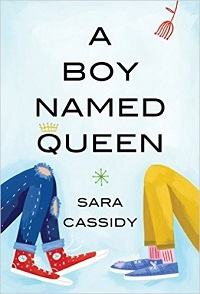| ________________
CM . . .
. Volume XXIII Number 11. . . .November 18, 2016
excerpt:
Despite being called A Boy Named Queen, this charming story is actually about a girl named Evelyn and her journey towards self-discovery. Evelyn lives with her parents in an extraordinarily structured life. On the last day of every summer vacation, the family dutifully scrubs the entire house and puts away all remaining vestiges of summer. They then go to buy Evelyn her new, practical loafers for the school year. Evelyn is careful and precise. She speaks quietly and enjoys math because “numbers always act as they should.” Her mother has told her to keep a damper on her imagination, and her fond wish for her daughter is that Evelyn becomes a government office worker. Into this sterile world bursts Queen. He is confident and witty, creative and quirky. Evelyn is drawn to his carefree spirit, and the two begin a friendship on their daily walk home from school. There is no major conflict in this book. Instead, you are witness to some minor bullying, but nothing more dramatic than snapping Queen’s pencils and poking fun at his name. Evelyn cannot understand how Queen is so calm in the face of what she considers torment, and he responds that he has a turquoise force field around himself that keeps the negative out and lets kindness in. He encourages Evelyn to erect her own force field to protect herself from bullies. There is also some subtle internal conflict as Evelyn begins to rebel against her own carefulness and her mother’s stringency. But this, too, is mild. Her most open act of rebellion is to wear some shoes with red stars on them that were given to her by Queen. Evelyn’s personal changes are slight enough as to feel incredibly realistic, and most readers will be able to identify with her hesitancy as she begins to step her toe past her own carefully drawn lines. A Boy Named Queen is written in simple present tense with quite short sentences. In some places, this can come across as stilted, but mostly it feels like a realistic account of Evelyn’s thought patterns. The book is also quite full of metaphors, some of them strange or even bizarre. At one point, the afternoon sky is described as white and wooly like a donkey’s belly. Evelyn then imagines “a great donkey straddling the world.” There is also a perplexing passage concerning Xeno’s Paradox that seemed slightly out of place, but mostly the language is appropriate for its intended audience. I quite enjoyed this short novel about a quiet and shy girl slowly learning to branch out of her shell. However, I found the ending quite abrupt as I would have liked to read more about Evelyn’s transformation and her friendship with Queen. Younger readers may find themselves similarly frustrated with the sudden end to the book. Overall, A Boy Named Queen is a delightfully quaint story that fans of realistic fiction will be sure to enjoy. Highly Recommended. Alise Nelson is a graduate of the Simon Fraser University and holds a Certificate in Liberal Arts as well as Bachelor’s Degrees in English and History. She is currently a Reader’s Advisor with the Prince George Public Library.
To comment
on this title or this review, send mail to cm@umanitoba.ca.
Copyright © the Manitoba Library Association. Reproduction for personal
use is permitted only if this copyright notice is maintained. Any
other reproduction is prohibited without permission.
Next Review | Table of Contents For This Issue - November 18, 2016 |
